 |
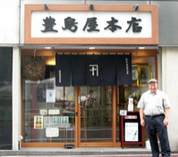 セインさん。今回、ご案内するのは「豊島屋本店」です。 豊島屋の創業は慶長元年(1596)、江戸に幕府がひらかれる前。鎌倉河岸という、江戸城をつくるための材木や石などが荷揚げされた場所に店を開いたのが始まりです。今日は、吉村隆之会長がお待ちかねです。さあ、入りましょう。 セインさん。今回、ご案内するのは「豊島屋本店」です。 豊島屋の創業は慶長元年(1596)、江戸に幕府がひらかれる前。鎌倉河岸という、江戸城をつくるための材木や石などが荷揚げされた場所に店を開いたのが始まりです。今日は、吉村隆之会長がお待ちかねです。さあ、入りましょう。
Thayne-san, today I’m going to introduce you to Toshimaya Honten. Toshimaya opened in the first year of the Keicho Era, in 1596, before the shogunate was established in Tokyo. The business began with a shop located next to where lumber and stone were unloaded for the building of Edo Castle called Kamakura-gashi. Today the owner, Yoshimura Takayuki, is expecting us. Okay, let’s go in. |
|
|
| (吉村) |
ようこそ、セインさん。吉村です。
Welcome, Thayne-san. I’m Yoshimura. |
|
|
 |
こんにちは、吉村さん。はじめまして。 400年以上も続いているお店のご主人だと聞いてきましたが、吉村さんが何代目なんですか?
Hello Yoshimura-san, pleased to meet you. I hear you’re the proprietor of a shop that’s been open for over 400 years. So what generation are you? |
|
|
| (吉村) |
15代目です。
The fifteenth.. |
|
|
 |
15代! やはり、小さい頃から店を継ぐように言われて育ったんですか?
Fifteenth! Were you told from a young age that you would take over the business? |
|
|
| (吉村) |
いえ、そういうことはありませんでした。大学も工学部で化学を専攻して、卒業後は企業に入って、高分子材料のビスコースの研究者として勤めていました。
No, actually I wasn’t. I majored in chemistry at university, and after graduating I worked for a company as a researcher of viscose polymeric materials. |
|
|
 |
すご~い。
Wow. |
|
|
| (吉村) |
研究の一環で、アメリカのブルックリン工科大学に留学していたこともあるんですよ。それが、ちょうど東京オリンピックの年(1964)で。ですから、僕は東京オリンピックを見ていないんです。
As part of my research, I spent some time at New York City College of Technology in Brooklyn in America. That just happened to be in the year of the Tokyo Olympics〈1964〉, so I actually missed it completely. |
|
|
 |
それは、ちょっと残念でしたね(笑)。
That’s too bad. |
|
|
| (吉村) |
それで、父から帰って来いと言われたのが40歳を過ぎてから。しぶしぶ42歳の時に戻ってきました。
When my father asked me to come back home I was in my 40s. I reluctantly returned at age 42 to take over the shop. |
|
|
 |
42歳! 研究者として一番、やりがいのある、おもしろい時期でしょう?42!
I imagine that was a time when you were most involved and excited about your research. |
|
|
| (吉村) |
そうなんです。だから結構、悩みましたよ。ほかに、誰かがやってくれないかな…なんて考えたり。でも、結局、長男が継ぐのが一番いいのだろうと決心して……。
Yes, that’s true. I thought long and hard about it, and I wondered if someone else couldn’t take over instead. But in the end, I decided that it was best for me, as the oldest son, to take over the shop, and that’s what I resolved to do. |
|
|
 |
それほど悩んでも、お店に戻ってこられたというのは、なぜですか?
After hesitating, what reasons did you have for returning? |
|
|
| (吉村) |
それが、伝統の重みというものだと思います。自分の代で絶やしてはいけない。店を発展させたいとか、もっと大きくしたい、というのではなくて、ともかく連続させていくのが自分の使命だと。今、社長をやってくれている息子も、やはり私と同じように研究職についていて、40歳で私が呼び戻したんです。私同様、 息子もいやだったと思いますが、帰ってきてくれました。
I think it was the weight of tradition. I felt I couldn’t let it die with my generation. It’s not that I wanted to develop or expand the business, but that it was my mission to at least keep it alive. My son, who’s now the company president, also got a job as a researcher, but when he was 40, I asked him to help with the shop. I think he disliked the idea just as much as I did at first, but he came back. |
|
|
 |
代々の人の、強い責任感で、家業が受け継がれてきたんですね。 ところで、豊島屋さんといえば、江戸時代からずっと作っておられる「白酒」が有名ですね。
Family businesses have succeeded for generations due to a strong sense of responsibility. By the way, the shirozake (sweet white sake) that you have been making since the Edo Period is especially famous, isn’t it? |
|
|
| (吉村) |
はい。白酒はお雛様、3月3日の桃の節句に欠かせないお酒です。セインさんは飲まれたことはありますか?
That’s right. Shirozake is considered essential for the Hina-matsuri (Doll’s Festival) on March 3. Thayne-san, have you had it before? |
|
|
 |
実は、ないんです。
Actually, no. |
|
|
| (吉村) |
じゃあ、ちょっと飲んでみてください。
Well, go ahead and try some. |
|
|
 |
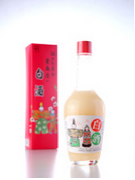 とろっとしていて、甘い!! おいしいですね。 江戸時代と同じ作り方をしているんですか? とろっとしていて、甘い!! おいしいですね。 江戸時代と同じ作り方をしているんですか?
It’s thick, and sweet! Very good. Do you use the same production methods you used in the Edo Period? |
|
|
| (吉村) |
はい。今も昔も、変わらぬ造り方です。寒さの厳しいなか、仕込んで、節句の前に売り出します。江戸時代に描かれた絵図を見ると、この白酒を買おうとお客様が押しかけている様子が描かれています。
We do. We make it the same way we always have. We ferment it in the cold of winter and begin selling it before Hina-matsuri. If you look at this woodblock print made in the Edo Period, you can see a huge crowd of people trying to buy shirozake. |
|
|
 |
うわ~! 本物の江戸時代の絵図ですか。 ものすごくたくさんの人が描かれていますね。
Whoa! Is this the original from the Edo Period? There sure are lots of people drawn here. |
|
|
| (吉村) |
お店に入るのと、出るのと、出入り口を2つ設けているでしょう? これで店の中を一方通行にして、混乱を防いでいたようです。半纏を着た鳶(とび)の人が いるものわかるでしょう? これは警備の人。それから、あまりの人混みで、気分が悪くなった人のために医者も待機させていたそうです。
You can see that the shop’s exit is separate from the entrance, right? That was to keep customers moving in one direction through the shop, to cut down on the confusion. You see these people wearing dark jackets? Those were carpenters hired by the shop to keep order. And they even had a doctor on hand in case someone got sick from the crowded atmosphere. |
|
|
 |
まさに、江戸の名物、名所だったんですね。
It was definitely a well-known specialty, and a famous place as well. |
|
|
 |
白酒の時期以外は、普通の日本酒を売っていたんですか。
Did you sell other kinds of sake outside of the shirozake season? |
|
|
| (吉村) |
ええ。当時、江戸やその近郊ではおいしい日本酒を造る技術がありませんでしたから、灘や伏見、池田といった関西の酒蔵の酒を仕入れて、売っていました。そして、今で言う居酒屋のようなこともしていました。ほぼ原価で売っていたんで、これもまた大変な人気だったといいます。
Yes. At the time, people in Edo and the surrounding area didn’t know how to make good sake, so we procured our sake from Nada, Fushimi and Ikeda sake breweries in the Kansai area. We also had a drinking area similar to modern-day izakaya. Here we sold our sake close to at-cost, so I hear it was really popular. |
|
|
 |
でも、原価で売ってたら、儲からないじゃないですか。
But if you sold your sake at cost, you couldn’t make any money, right? |
|
|
| (吉村) |
そこがおもしろいところで、酒では儲けずに、酒が入っていた樽を売って儲けていたんです。それから、当時は、支払いは年に1度・2度で、一方、日銭は毎日、入ってくるでしょう。ですから、そのお金で高利貸しのようなこともしていたようです。 時が流れて、自分のところでも酒を造ろうということになったのは、明治時代の後期からです。当初は関西で造っていましたが、今は東京都下の東村山市で、「金婚」というブランドでつくっています。 明治神宮、神田明神、日枝神社、という東京を代表する3つのお社の御神酒になっているのは、当社だけなんですよ。
Interestingly enough, although we didn’t make lots of money on the sake itself, we made profits by selling the sake barrels. And at the time, we only had to pay once or twice a year, whereas we had revenue come in every day. So with that money the shop was also involved in something like lending. With time, at the end of the Meiji Period, we began to make our own sake. At first the sake was produced in Kansai, but today it’s made in Higashi Murayama in western Tokyo under the Kinkon brand. We’re the only company to make sake used as sacred sake at the three major shrines in Tokyo of Meiji Shrine , Kanda Shrine and Hie Shrine. |
|
|
|
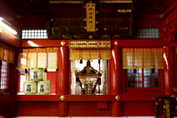 |
|
|
 |
すばらしい。今度、神社に行ったら、気を付けて見てみます。 実は僕も酒づくりには縁があって、僕のおじいさんのおじいさんくらい前の先祖が、スコットランドでお酒を造っていたんです。
Fantastic. I’ll take a close look the next time I go to one of them. Actually I have a connection with brewery history as well; my grandfather’s grandfather ran a brewery in Scotland. |
|
|
| (吉村) |
これはまた、すばらしいご縁ですね。ぜひ、これからもよろしくお付き合いください。
That sounds like providence! |
|
|
 |
こちらこそ宜しくお願いします。ぜひ、世界の人においしい日本のお酒を知ってもらいたいと思っています。
I’d certainly like to see more people from around the world introduced to good Japanese sake. |
|
|
|
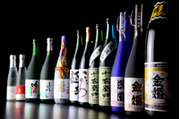 |
|
|
 |
吉村さん。先ほどは、実はいやいや戻ってきたんだ、という昔話も聞きましたが、今、この仕事をされていて、一番の魅力は何ですか?
Yoshimura-san, you talked about how you reluctantly took over the shop from your father mid-career. But what do you like about this job now? |
|
|
| (吉村) |
それはもう、おいしく飲んでいただけるということが、何よりありがたいことです。「おいしい」「おいしかったよ」と言われることを喜びとしてやっているわけです。
More than anything else, I love to see people enjoy our sake. I do it just to hear people say how much they like it. |
|
|
  |
ありがとうございました。
Thank you very much. |
|
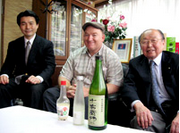 |
|
(文)太田美代
(英訳)デイビッド・A・セイン |
 1959年、米国生まれ。証券会社勤務を経て来日し、翻訳・通訳など多岐にわたって活躍。豊富な教授経験を生かし、数多くの英語関係書籍を執筆。近著に『日本人のチョットへんな英語』(アスコム)、『超入門シャドーイング』(主婦の友社)、日本人が使いすぎる英語(PHP文庫)など多数。
1959年、米国生まれ。証券会社勤務を経て来日し、翻訳・通訳など多岐にわたって活躍。豊富な教授経験を生かし、数多くの英語関係書籍を執筆。近著に『日本人のチョットへんな英語』(アスコム)、『超入門シャドーイング』(主婦の友社)、日本人が使いすぎる英語(PHP文庫)など多数。

 セインさん。今回、ご案内するのは「豊島屋本店」です。 豊島屋の創業は慶長元年(1596)、江戸に幕府がひらかれる前。鎌倉河岸という、江戸城をつくるための材木や石などが荷揚げされた場所に店を開いたのが始まりです。今日は、吉村隆之会長がお待ちかねです。さあ、入りましょう。
セインさん。今回、ご案内するのは「豊島屋本店」です。 豊島屋の創業は慶長元年(1596)、江戸に幕府がひらかれる前。鎌倉河岸という、江戸城をつくるための材木や石などが荷揚げされた場所に店を開いたのが始まりです。今日は、吉村隆之会長がお待ちかねです。さあ、入りましょう。 とろっとしていて、甘い!! おいしいですね。 江戸時代と同じ作り方をしているんですか?
とろっとしていて、甘い!! おいしいですね。 江戸時代と同じ作り方をしているんですか?







